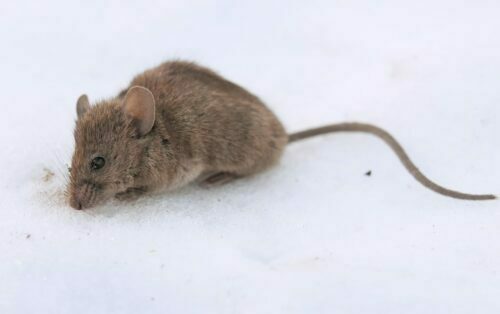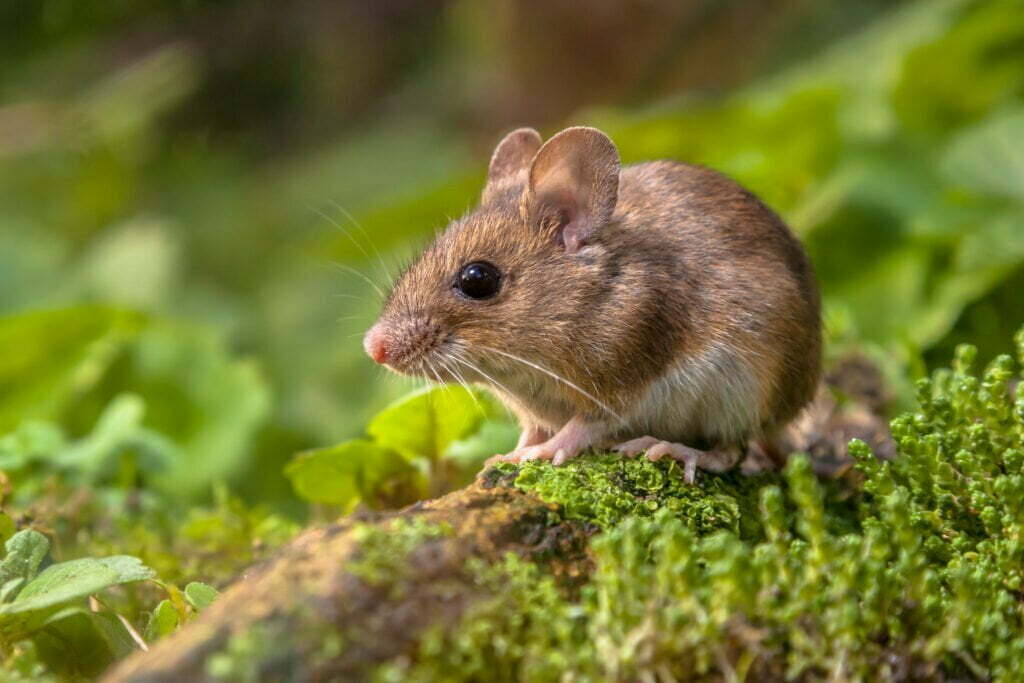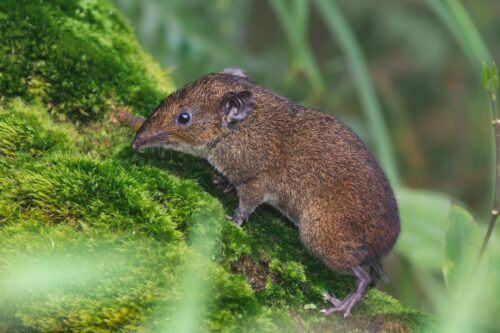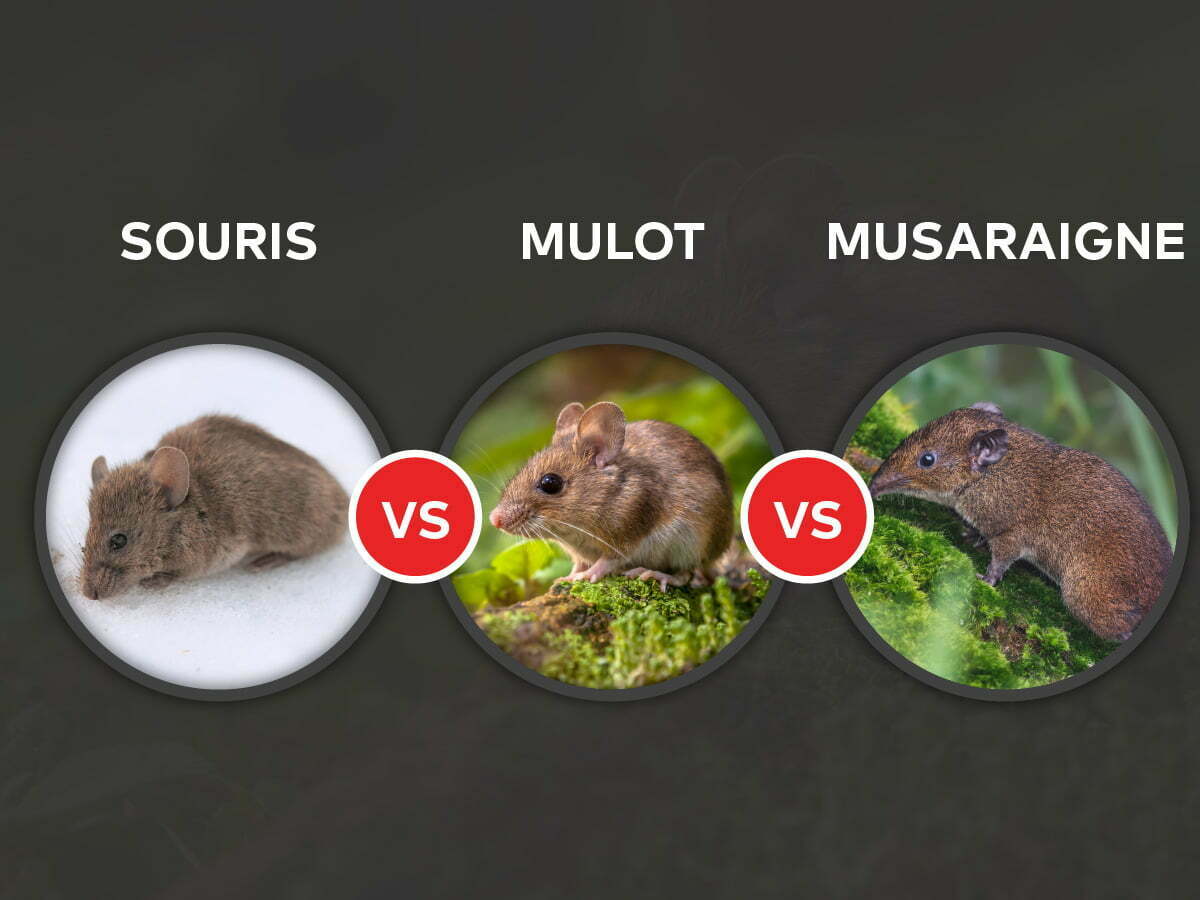Is your sleep being disrupted by a problem with rodents in your home? You’re not alone. Our team of exterminators receive dozens of calls each week, especially in winter months.
However, before you decide on a course of action, it’s important to identify the species from the list of the following possible suspects: the common mouse, the field mouse, and the shrew, three small mammals that look similar and with whom we all share our environment, even here in the Greater Montréal region!
How to recognize the common mouse in Québec

Latin name: Mus musculus
French name: Souris commune
The common mouse is one of the most widespread small rodent species in the province of Québec, both in urban and rural settings. It can thrive in nature without difficulty, but because of its great sense of adventure and extremely varied tastes, it often tends to live near humans so as to take advantage of their food, water, and houses. For this reason, as soon as fall and winter begin to set in, many people call on the services of exterminators who specialize in mouse infestations..
You’re probably dealing with a mouse if:
- Its colour is a uniform grey-brown with a grey abdomen, white toes and a scaly tail, sparsely covered with fine hairs
- It has big eyes and ears; its front paws have 4 fingers and its hind paws have 5
- It’s 7 to 9.5 cm long and its tail is often as long as its body
Other characteristics that can help you distinguish a mouse from a field mouse or a shrew:
- Weight: 12-30 g
- Habitat: Fields or wooded areas during the summer; it digs burrows measuring 10 to 835 cm long, each having 1 to 8 distinct tunnel segments and several chambers. When it lives in association with humans, the common mouse tries to infiltrate buildings in winter and builds its nest using rags, paper, or other soft materials. It can settle in ceilings, walls, under floors, in a drawer, a cupboard, or a mattress. It concentrates its activity within a radius of 3 to 10 metres from its nest.
- Eating habits: In nature, the common mouse feeds on roots, seeds, stems, leaves, mushrooms, insects and small vertebrates; however, when it lives near humans, it eats the same foods as them (including meat), as well as their waste products, glue, or soap.
- Special characteristics: good runner, up to 13 km/hour; good climber and jumper; the common mouse is able to swim.
What does a field mouse look like in Québec?

Latin name: Apodemus sylvaticus
French name: Mulot
The field mouse is often confused with the common mouse because it does not fear to live near humans. However, its diet is different, and this will have an impact on its contacts with humans.
You’re probably dealing with a field mouse if:
- Its colour is beige, rust or dark brown, with a white abdomen
- Its eyes and ears are smaller than a mouse’s; its snout is rounded and short
- It is up to 10.5 cm long, and its tail measures another 6 to 9 cm
Other characteristics that can help you distinguish a field mouse from a common mouse or a shrew:
- Weight: 20-35 g
- Habitat: uncultivated fields, green meadows, wetlands (near rivers, lakes, marshes); near forests and clearings. It builds its nest away from predators: in a bush, under a pile of rocks, in a tree stump or small burrow; it makes its nest out of dried grass.
- Eating habits: seeds, young plants and shoots, berries, insects, mushrooms, snails, worms, root vegetables (carrots, squash, etc.); corn, wheat or oat crops.
- Special characteristics: an excellent jumper; its hind legs are stronger than a mouse’s. It stays active in winter, staying mostly below ground; feeds on the food stored in tunnels. These tunnels and mounds of earth often become visible in spring when the snow melts.
The shrew: a mammal often found on the South-Shore and in Montréal

Latin name: Blarina brevicauda, named “short-tailed shrew”, the largest among the 8 species of shrews found all over the province of Québec. The North American water shrew (Sorex palustris) is also present in Québec; it is an excellent swimmer and feeds on crustaceans, larvae and small fish.
French name: Grande musaraigne
The shrew is sometimes incorrectly called a vole or a vole mouse. Contrary to what many presume, the shrew is not a rodent, but simply an insect-eating mammal.
Because of its diet, it is unlikely a shrew will choose to settle in a building, except to find shelter in cases of extreme cold, or to chase after insects it wants to eat.
You’re probably dealing with a shrew if:
- Its hair coat is dark, almost black, and uniform (Blarina brevicauda)
- Its tail is small; it has a long, hairy and pointed snout that looks like a small trunk; it has short legs each with 5 clawed fingers
- Size: 9 to 15 cm
Other characteristics that can help you distinguish a shrew from a field mouse or a common mouse:
- Weight: 16 to 29 g
- Habitat: mature hardwood forests; it digs up burrows and galleries in the layer of humus and decomposing vegetation on the forest floor
- Eating habits: it has a voracious appetite and eats its weight in insects, snails, slugs, fruit, seeds, small mammals and birds on occasion. Its heart beats at 800 beats per minute, which pushes its metabolism to extreme speeds. For this reason, the shrew spends most of its days frantically searching for food. It can locate insect larvae in the ground to a depth of 15 cm.
- Special characteristics: To help immobilize its prey (like large insects or birds), the shrew is able to inject its saliva (which is venomous) into its prey (like large insects or birds) to immobilize them. This way it preserves them alive and fresh in its tunnels.
Are these animals active in winter?
Yes; in fact, none of them hibernate in the strict sense of the term. Their behaviour may change somewhat, but if they are located near a heated building, they will most likely try to use it to survive and even multiply during the winter months. This is why the professionals at Avalanche Extermination are always ready to inspect the premises to discover the source of any problem caused by mice, field mice, or shrews.
If you have discovered or captured what looks like a mouse in your home and would like a specialist’s opinion, contact our team of exterminators to forward them a picture for identification.

